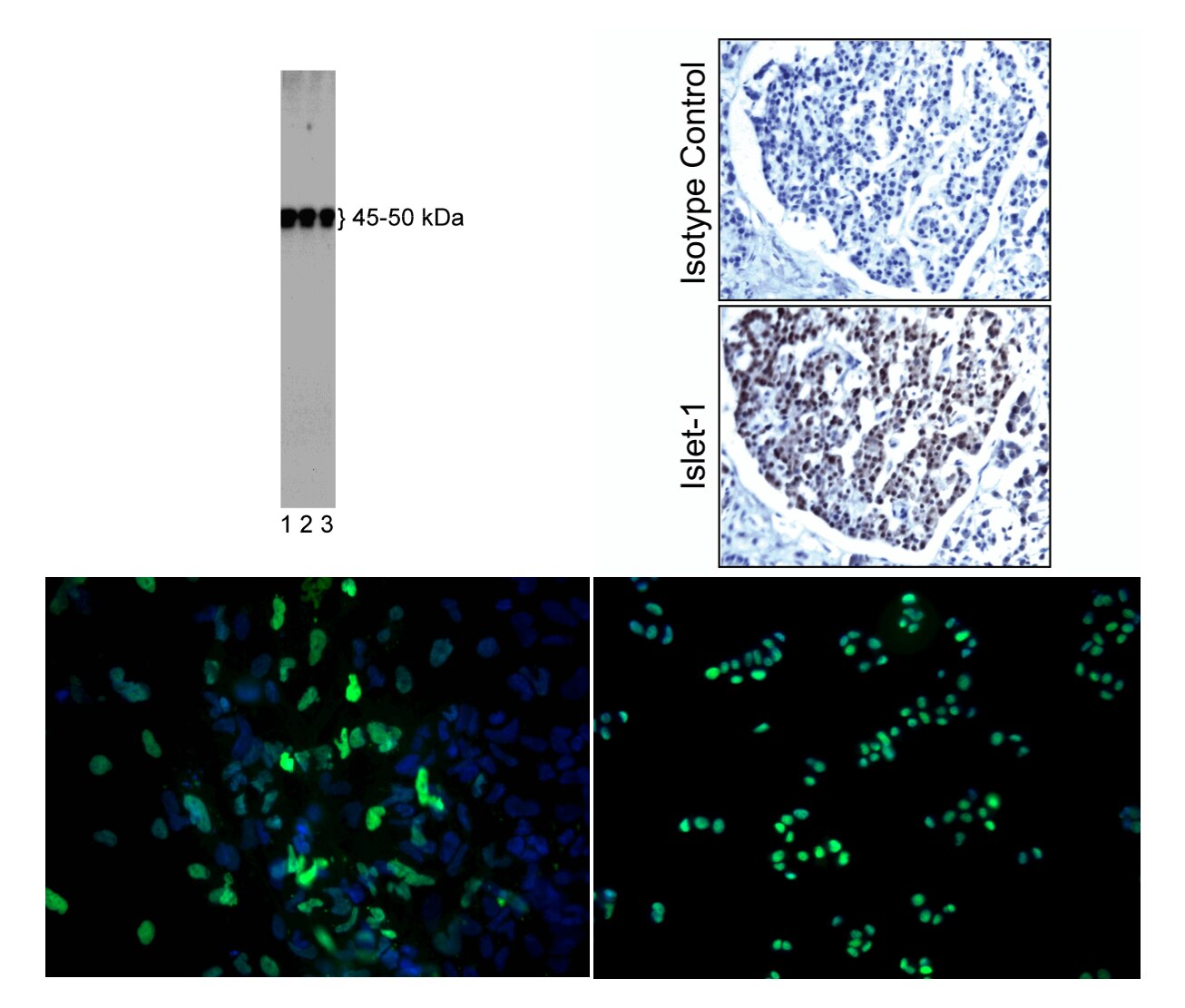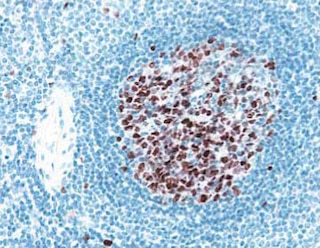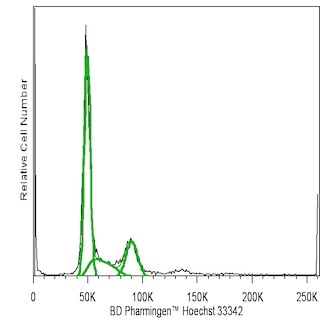-
Your selected country is
Middle East / Africa
- Change country/language
Old Browser
This page has been recently translated and is available in French now.
Looks like you're visiting us from {countryName}.
Would you like to stay on the current country site or be switched to your country?




TOP LEFT: Western Blot analysis of Islet-1 in mouse pancreatic tumor (insulinoma). Lysate from Beta-TC-6 cells (ATCC CRL-11506™) was probed with Purified Mouse anti-Islet-1 monoclonal antibody at titrations of 0.5 (lane 1), 0.25 (lane 2), and 0.125 μg/ml (lane 3). Islet-1 is identified as a band of ~45-50 kDa. TOP RIGHT: Immunohistochemical staining of human Islet-1. Following antigen retrieval with BD Retrievagen A buffer (Cat. No. 550524), formalin-fixed paraffin-embedded human pancreas sections were stained with either purified mouse IgG1, κ Isotype control (Cat. No.550878, top panel) or Purified Mouse Anti-Human Islet-1 (Cat. No.562546, bottom panel). A three-step staining procedure that employs Biotin Goat Anti-Mouse Ig secondary antibody (Cat. No. 550337), Streptavidin HRP (Cat. No. 550946), and DAB substrate kit (Cat. No. 550880) was used. As shown in the figure, the lslet-1 staining is mainly nuclear in the pancreas islet. Original magnification: 40X. BOTTOM ROW: Immunofluorescent staining of Islet-1 in spontaneously differentiated human embryonic stem (ES) cells (left panel) and mouse pancreatic tumor (insulinoma) cells (right panel). Spontaneously differentiated (Emre et al., 2010) H9 human ES cells (WiCell, Madison, WI) and Beta-T-C6 cells (ATCC, CRL-11506™) were fixed with BD Cytofix™ Fixation Buffer (Cat. No. 554655), permeabilized with BD Phosflow™ Perm Buffer III (Cat. No.558050), and stained with Purified Mouse anti-Islet-1 monoclonal antibody (pseudo-colored green) at 1.25 μg/mL. The second-step reagent was Alexa Fluor® 488 goat anti-mouse Ig (Life Technologies). Nuclear staining (pseudo-colored blue) was either with DAPI (left panel) or Hoechst 33342 (Cat. No. 561908, right panel). The images were captured on a BD Pathway™ 435 Cell Analyzer and merged using BD AttoVision™ Software.


BD Pharmingen™ Purified Mouse anti-Islet-1

Regulatory Status Legend
Any use of products other than the permitted use without the express written authorization of Becton, Dickinson and Company is strictly prohibited.
Preparation And Storage
Recommended Assay Procedures
For more information please refer to the resources located on the BD Biosciences webpage: http://www.bdbiosciences.com/support/resources/index.jsp
Product Notices
- Since applications vary, each investigator should titrate the reagent to obtain optimal results.
- Please refer to www.bdbiosciences.com/us/s/resources for technical protocols.
- Alexa Fluor® is a registered trademark of Molecular Probes, Inc., Eugene, OR.
- Caution: Sodium azide yields highly toxic hydrazoic acid under acidic conditions. Dilute azide compounds in running water before discarding to avoid accumulation of potentially explosive deposits in plumbing.
- Sodium azide is a reversible inhibitor of oxidative metabolism; therefore, antibody preparations containing this preservative agent must not be used in cell cultures nor injected into animals. Sodium azide may be removed by washing stained cells or plate-bound antibody or dialyzing soluble antibody in sodium azide-free buffer. Since endotoxin may also affect the results of functional studies, we recommend the NA/LE (No Azide/Low Endotoxin) antibody format, if available, for in vitro and in vivo use.
Companion Products






Islet-1 is a LIM-homeodomain transcription factor important for motor neuron differentiation and the formation of islet cells in the pancreas. Various heart cell types, such as cardiac muscle, the conduction system and endothelial cells in multiple heart tissue compartments during cardiogenesis, have been found to originate from Islet-1-positive cardiac precursor cells. Moreover, Islet-1-positive cells from differentiated human embryonic stem cell lines were found to be capable of self-renewal and expansion and could differentiate into the three major cell types of the heart.
Western blot analyses of lysates from transfected cells demonstrate that the Q11-465 monoclonal antibody reacts with human Islet-1 (ISL-1, ISL1) and Islet-2 (ISL-2, ISL2), similar to the 4D5 clone (Tsuchida et al, 1994). Cross-reactivity with mouse Islet is also observed.
Development References (7)
-
Bu L, Jiang X, Martin-Puig S, et al. Human ISL1 heart progenitors generate diverse multipotent cardiovascular cell lineages. Nature. 2009; 460(7251):113-117. (Biology). View Reference
-
Ebert AD, Yu J, Rose FF Jr, et al. Induced pluripotent stem cells from a spinal muscular atrophy patient. Nature. 2009; 457(7227):277-280. (Biology). View Reference
-
Emre N, Vidal JG, Elia J, et al. The ROCK inhibitor Y-27632 improves recovery of human embryonic stem cells after fluorescence-activated cell sorting with multiple cell surface markers. PLoS ONE. 2010; 5(8):e12148. (Methodology: Cell differentiation). View Reference
-
Laugwitz KL, Moretti A, Caron L, Nakano A, Chien KR. Islet1 cardiovascular progenitors: a single source for heart lineages. Development. 2008; 135(2):193-205. (Biology). View Reference
-
Osumi N, Hirota A, Ohuchi H, et al. Pax-6 is involved in the specification of hindbrain motor neuron subtype. Development. 1997; 124(15):2961-2972. (Biology). View Reference
-
Tsuchida T, Ensini M, Morton SB, et al. Topographic organization of embryonic motor neurons defined by expression of LIM homeobox genes. Cell. 1994; 79(6):957-970. (Biology). View Reference
-
Xu C, Police S, Hassanipour M, et al. Efficient generation and cryopreservation of cardiomyocytes derived from human embryonic stem cells. 2011; 6(1):53-66. (Biology). View Reference
Please refer to Support Documents for Quality Certificates
Global - Refer to manufacturer's instructions for use and related User Manuals and Technical data sheets before using this products as described
Comparisons, where applicable, are made against older BD Technology, manual methods or are general performance claims. Comparisons are not made against non-BD technologies, unless otherwise noted.
For Research Use Only. Not for use in diagnostic or therapeutic procedures.
Report a Site Issue
This form is intended to help us improve our website experience. For other support, please visit our Contact Us page.